1Lt. Harold E. Honhart
Buffalo, NY
Originally from Warren, PA
New York National Guard
65th Infantry Regiment
F, I Companies
Reorganized into:
3rd Field Artillery Regiment
Battery C
Punitive Expedition,
Mexican Border War
Redesignated as:
106th Field Artillery Regiment
American Expeditionary Forces
First World War, France
Air Service, American Expeditionary Forces
Aerial Observer
Sopwith 1½ Strutter
2nd Air Instruction Center
First World War, France
Injured in Flying Accident
Harold Ernst Honhart was born on October 1st, 1889 in Warren, Pennsylvania. I do not know
when or for what reason he moved to Buffalo, New York, but on April 1st, 1912 he enlisted
in the New York National Guard, joining F Company of Buffalo's 65th Infantry Regiment.
Over the next few years, Harold re-upped with the Guard twice and was promoted twice,
though I have found conflicting information regarding some of the dates concerned.
For example, one source states that he was promoted to sergeant in June of 1916,
but this news article from 1914 would seem to disagree:
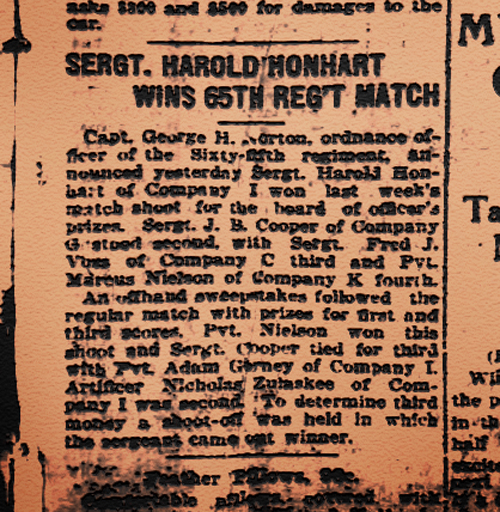
From: Buffalo Courier March 22nd, 1914 edition via FultonHistory.com
In mid-June of 1916 the New York National Guard was mobilized for duty at the Mexican Border.
At this time the 65th Infantry Regiment was reorganized into the 3rd Field Artillery Regiment
and, due to the additional training required by the conversion, the outfit was not officially drafted
into federal service until August 5th, and did not depart with the rest of the NYNG outfits in July.
Instead, the 3rd FA spent the next three months at Camp Whitman, New York, learning to fire
the big guns, and was among the last of the NYNG outfits to head south, its first elements
departing October 3rd and arriving at Camp McAllen, Texas on October 9th & 10th, 1916.
On January 24th, 1917 Harold was commissioned as a second lieutenant. (He was listed in the
April-June 1917 issue of the Field Artillery Journal as being with Battery C.) Almost a month
and a half later, on March 6th, after five largely uneventful months at the border,
the 3rd Field Artillery Regiment left Camp McAllen, returned home to Buffalo,
and was mustered out of Federal Service on March 17th, 1917.
You can learn more about the NYNG's involvement in the Mexican Border War
HERE.
Camp McAllen, Texas, 1916.

From: McAllen - Leading The Way : The First 100 Years (Full eBook
HERE) -
Larger Image
On April 2nd, 1917, the USA entered the war in Europe and the New York National Guard was once
again called upon to serve, being drafted into Federal Service in July of 1917. The whole of the NYNG,
previously designated the 6th Division, was renumbered as the 27th Division, and its regiments were
also renumbered, with the 3rd Field Artillery Regiment becoming the 106th Field Artillery Regiment.
Though already in the National Guard, Harold was still required to register for the draft, which
he did on June 5th, 1917. His draft card shows that he was working as a machinist at the Curtiss
Aeroplane and Motor Company's Austin Street plant in Buffalo, was married, and had two children.
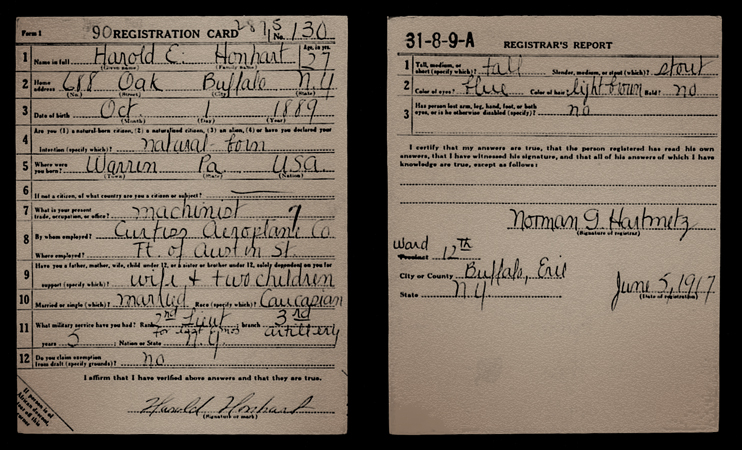
National Archives and Records Administration via Fold3 -
Larger Image
In late August of 1917 the regiments of the New York National Guard began moving south to
Camp Wadsworth near Spartanburg, South Carolina. Harold arrived with the 106th Field Artillery
Regiment on September 28th, was promoted to first lieutenant on December 5th, and, with the rest of
the 27th Division, spent that winter and a good part of the following spring training to go to war.
Camp Wadsworth at Spartanburg, South Carolina.
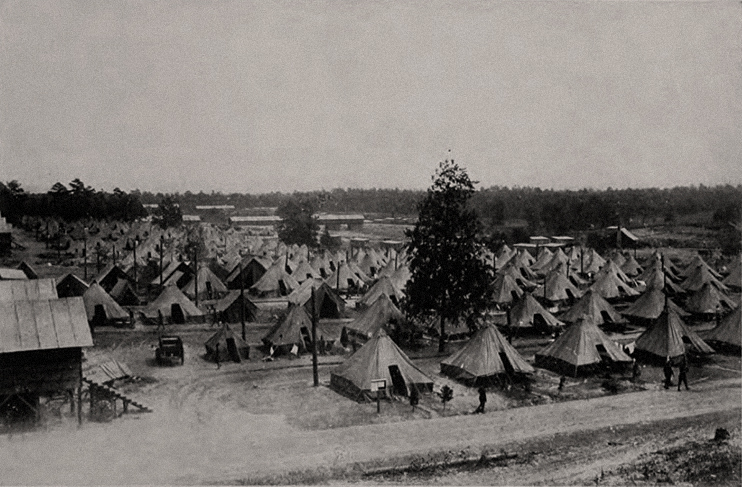
From: The Pictorial Record of the 27th Division compiled by Alexander Starlight (Full Book
HERE) -
Larger Image
The first elements of the 27th Division would head overseas in May of 1918, with the remainder,
including the 106th Field Artillery Regiment, arriving at Brest, France by the end of June.
This partial page from a US Army Transport Service passenger list shows that Harold sailed
for France aboard the USS Matsonia (ID-1589) from Newport News, Virginia on June 6th, 1918.
The other fella listed, Capt. Harry Gilchriese, was the commander of Provisional Company No.7.
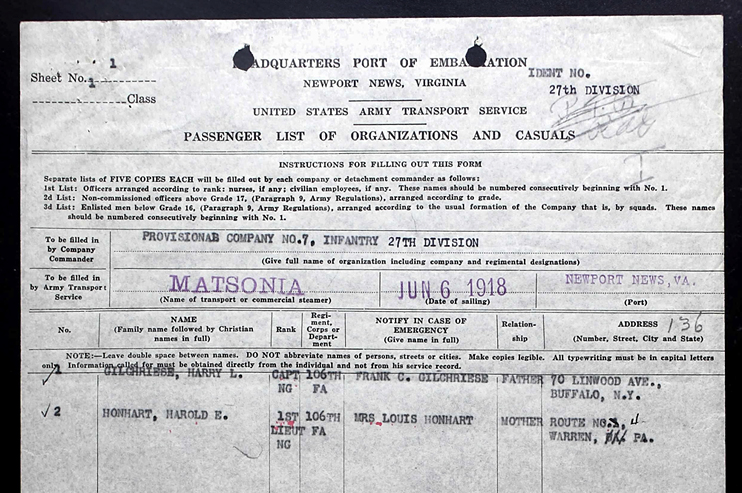
National Archives and Records Administration via Fold3 -
Larger Image
Formerly an ocean liner operated as the SS Matsonia by the Matson Navigation Company,
USS Matsonia carried more than 13,000 American troops to Europe on six round-trips during the
war. After the war, she would bring more than 23,000 home over the course of eight trips.
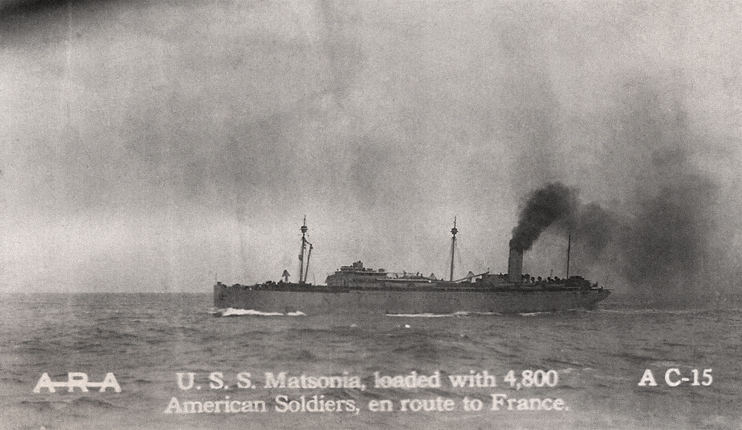
Project 914 Archives -
Larger Image
Though he traveled to France with the 106th Field Artillery Regiment, Harold was not to
remain with his outfit for long. At some point he received orders to report for duty
with the Air Service, AEF and was ultimately sent to the 2nd Air Instruction
Center at Tours, Indre et Loire, France to undergo training as an aerial observer.
The 2nd Air Instruction Center at Tours Aerodrome.
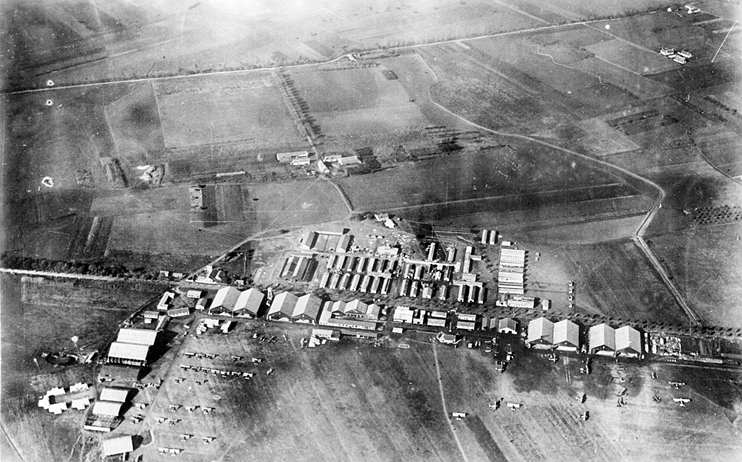
From: Gorrell's History of the American Expeditionary Forces Air Service, 1917-1919
National Archives and Records Administration via Fold3 & Wikipedia -
Larger Image
During this training Harold would have learned how to spot for artillery from the air,
which is why many aerial observers were taken from the ranks of the artillerymen. He
would also have learned the art of aerial photography as well as that of aerial gunnery.
There were a number of aircraft types used for training, but the most prevalent at
Tours seems to have been the Sopwith 1A.2, a variant of the British Sopwith 1½ Strutter
that was built under license by the French. By 1918 it was an aging design, but was used
to good effect as a trainer and served with the Air Service, AEF for a time as an
interim two-seat combat type until later designs were available in greater numbers.
These next three photos show Sopwiths at Tours. Harold may have trained in any of these kites.
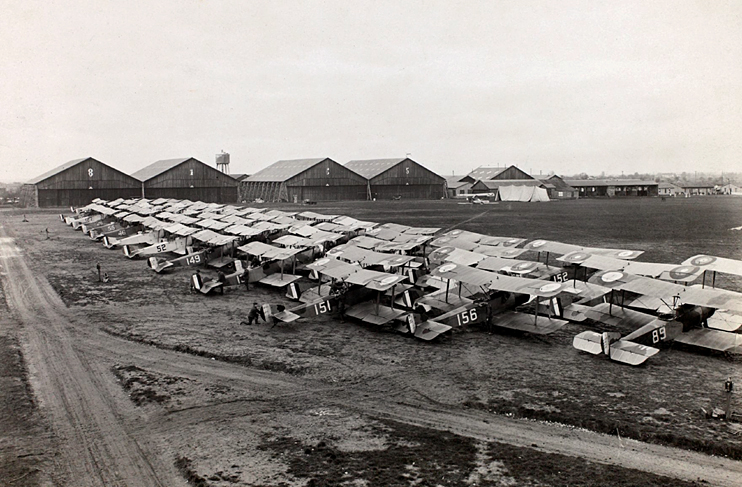
San Diego Air and Space Museum Archives -
Larger Image
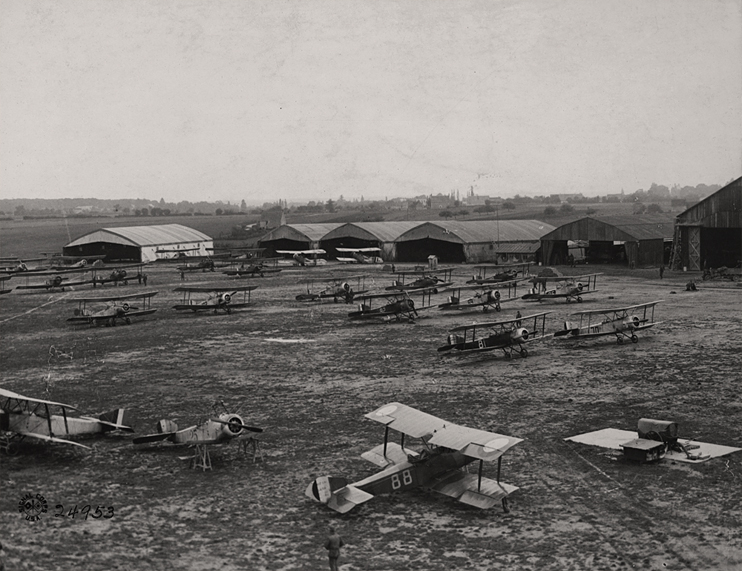
National Archives and Records Administration (Signal Corps photo) -
Larger Image
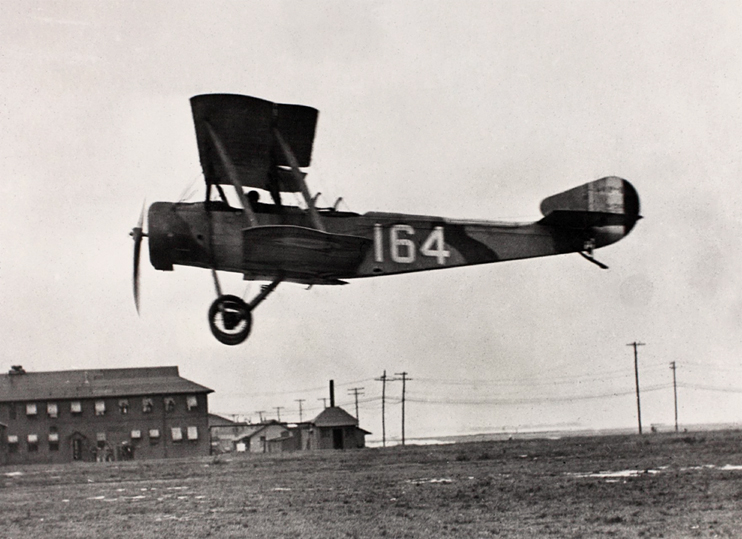
San Diego Air and Space Museum Archives -
Larger Image
At the beginning of the war the aeroplane was deemed to be of little use by many stubborn and
short-sighted military commanders; the old guard. But some saw the potential value of those strange
flying machines which eventually proved their worth through reconnaissance operations alone. By the
end of the war, tens of thousands of aerial photos had been taken, and hundreds of thousands of
prints made, which kept ground commanders informed as to the current status of a given battlefront.
Countless missions were flown to spot for individual artillery batteries, the aerial observers
providing invaluable assistance to the gunners on the ground, allowing them to correct their fire
both rapidly and with great accuracy. Enemy troop movements were also reported to great effect,
with many an enemy flanking maneuver and attempt at encirclement frustrated.
As an observer, Harold would have been among the most vital of cogs in the aerial reconnaissance
machine. He would have been in command of each mission; from planning each flight, working
out the navigational details, to making the observations and getting the photos, every
single mission would have been his show until the objectives were complete.
In this photo, an observer briefs his pilot on which routes to fly, altitudes, etc., while an aerial
camera is loaded into the observer's cockpit, to be mounted on a port looking through the bottom
of the aircraft. Note the film magazine resting atop the fuselage just aft of the observer's cockpit.
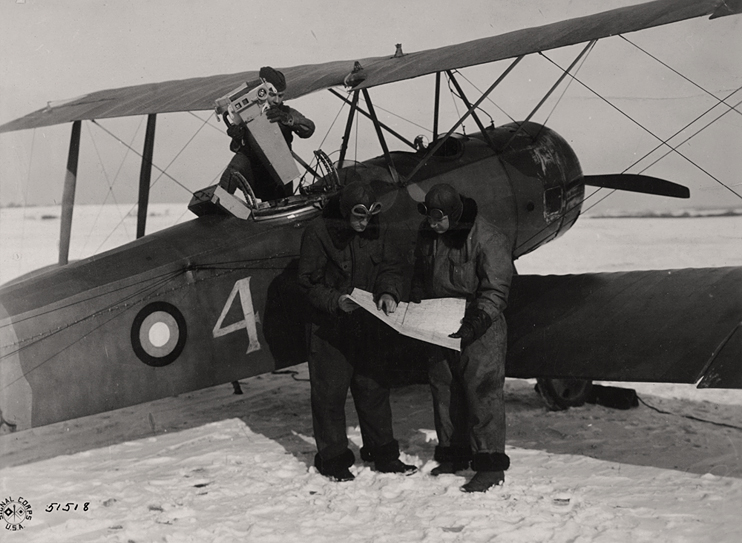
National Archives and Records Administration (Signal Corps photo by Lt. Sears) -
Larger Image
This view shows the pilot and observer settled into their Sopwith, ready to go.
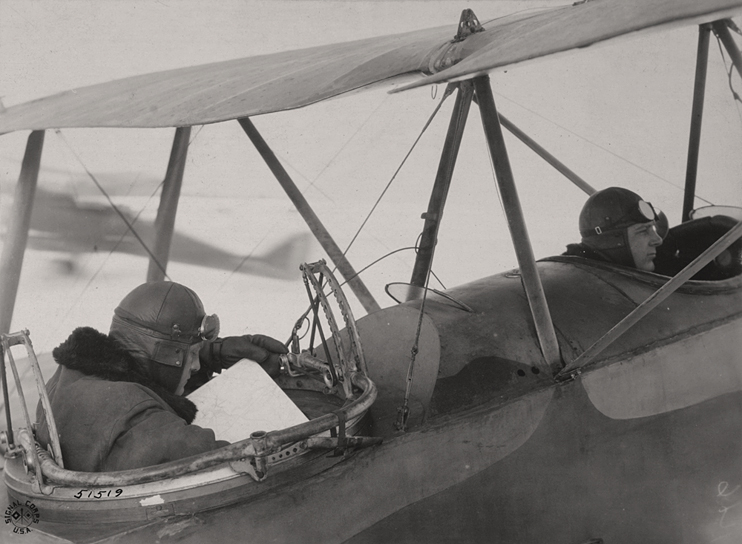
National Archives and Records Administration (Signal Corps photo by Lt. Sears) -
Larger Image
And this view shows a Sopwith observer's position with defensive guns mounted.
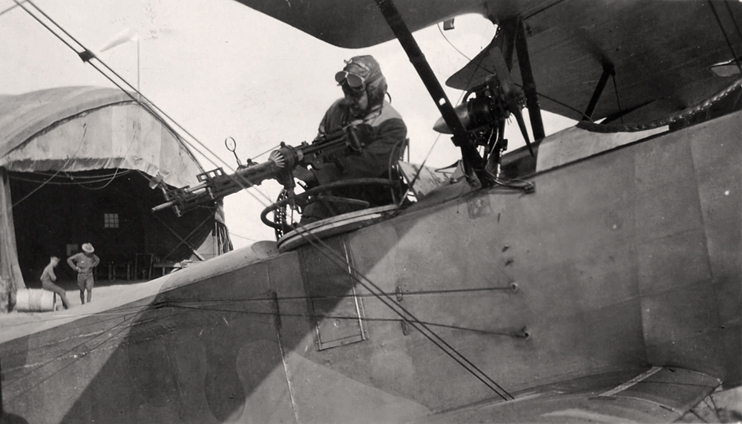
San Diego Air and Space Museum Archives (Philip Babcock collection) -
Larger Image
Sadly, training accidents claimed many an aviator before they even got into the fight.
On October 10th, 1918, Harold was badly injured when his Sopwith crashed on takeoff from Tours:

From: History of Buffalo and Erie County 1914-1919 compiled by Daniel J. Sweeney -
Larger Image
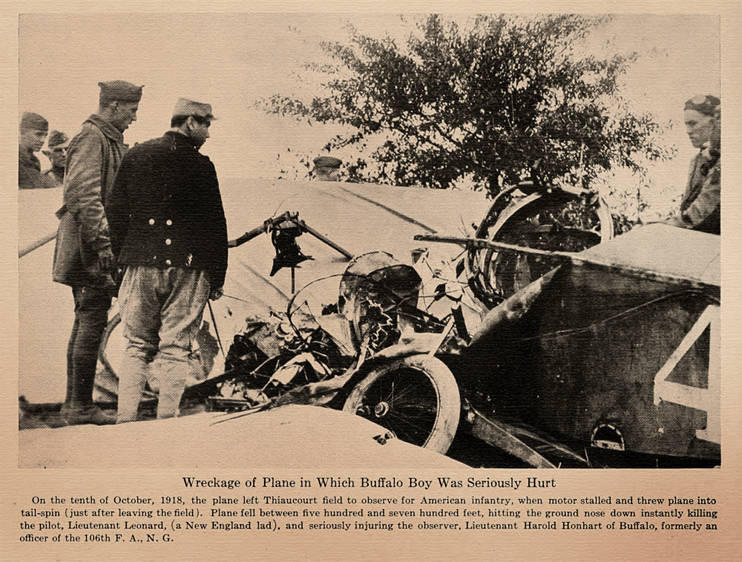
From: History of Buffalo and Erie County 1914-1919 compiled by Daniel J. Sweeney -
Larger Image
The caption from the above image states that Harold's airplane was flying from 'Thiaucourt
field', whereas the information for a print of the same photo that's held by the National
Archives very specifically identifies the location as 'Second Air Instruction Center at Tours,
Indre et Loire, France'. And as that info was furnished by the Signal Corps photographer who
took the photo, I am inclined to regard said portion of the above caption as erroneous.
The portion of the caption concerning the pilot, Lt. W.B. Leonard, also appears to be in error,
as it seems that he was not in fact a 'New England lad' but was apparently from Iowa.
See Warren Brown Leonard's 'Find a Grave' Memorial
HERE.
Here's a much clearer scan of a first generation print of the above photo. The cockeyed ring in the
fuselage, above and to the right of the wheel, is the gun mount for the observer's cockpit.
That's where Harold was seated.
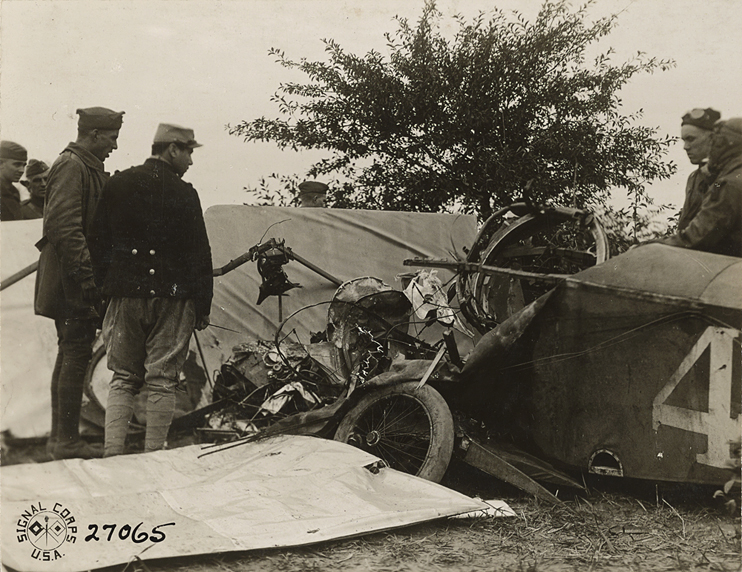
National Archives and Records Administration (Signal Corps photo by Pvt. C.L. Eddy) -
Larger Image
Another view of the wreck. It's something of a miracle that the kite did not burn, as was often
the case in such accidents as this, especially given that the incident happened on takeoff and
the bird likely had a full fuel load. Despite his inuries, Harold was one lucky fella.
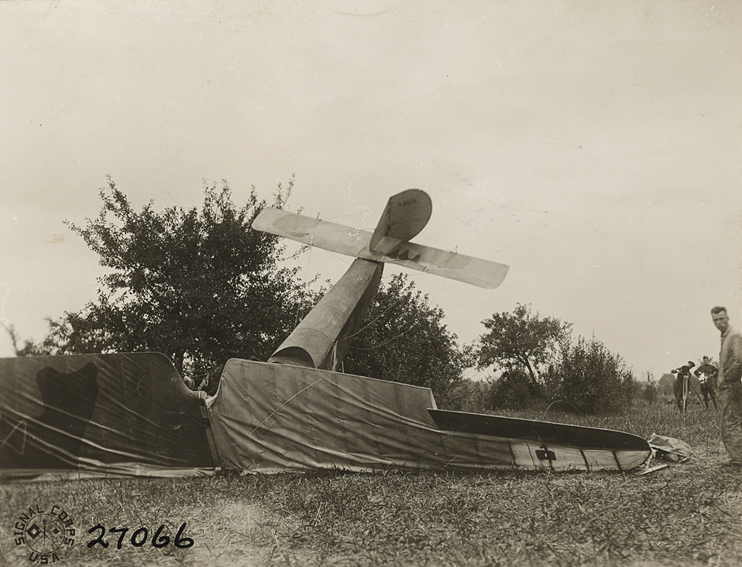
National Archives and Records Administration (Signal Corps photo by Pvt. C.L. Eddy) -
Larger Image
I haven't been able to find out where Harold was taken after the accident or at which hospital
in France he was treated before heading back to the USA in January of 1919, but he spent an
unknown (to me) amount of time at Walter Reed General Hospital in Takoma Park, DC
before he was honorably discharged from the National Guard on March 29th, 1920.
This document, the exact purpose of which is unclear to me at the time of this writing, shows
that Harold was deemed to be 80% disabled at the time of his discharge in March of 1920.
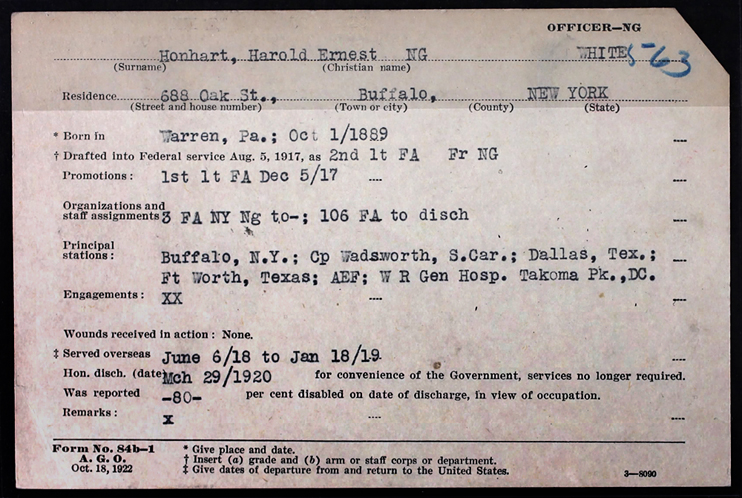
National Archives and Records Administration via Fold3 -
Larger Image
Though he was considered disabled upon his discharge from the National Guard, Harold may
have recovered and resumed active service with the Guard at some point, but I have found no solid
info to confirm this, as of this writing. Aside from the above document, which dates from no earlier
than October 18th, 1922, the only reference I have found to him in connection with the military
after his discharge in 1920 is in Volume II of the Official Army Register (published in 1955),
which lists his final rank of first lieutenant and his retirement date of January 30th, 1929.
Perhaps he was designated as a sort of 'injured reserve'?
Harold eventually returned to Warren, PA, though I do not know when, and apparently lived
out the rest of his life there and at Vero Beach, Florida, where he built a winter house.
This is the only photo of Harold Honhart that I have found, taken at Vero Beach, Florida
sometime in the 1940s. Looks like the Honhart clan ate quite well that night!
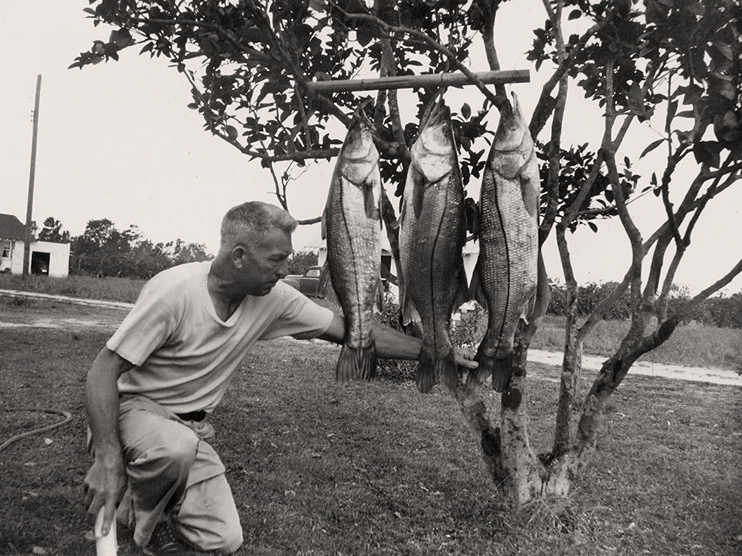
Denny Honhart via Gail Ott Brown (Posted in the 'Growing Up in Vero Beach' Group on Facebook) -
Larger Image
Building the winter house at Vero Beach, 1937. This shot may also show Harold, up on the roof,
though I am not certain which of the three he may be. My money's on the fella to the right.
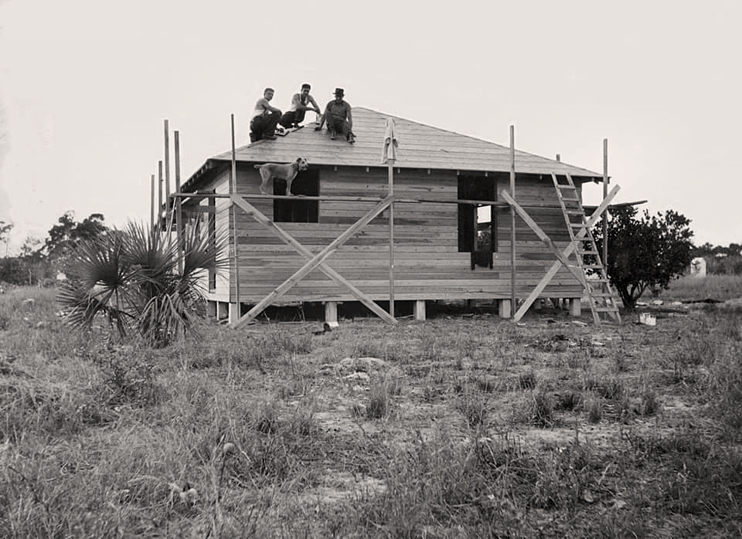
Denny Honhart via Gail Ott Brown (Posted in the 'Growing Up in Vero Beach' Group on Facebook) -
Larger Image
Harold E. Honhart went West on January 19th, 1957.
You can see his 'Find a Grave' Memorial
HERE.
Back to 'WNY Vets - USAAS'
Back to 'WNY Vets - US Army'










